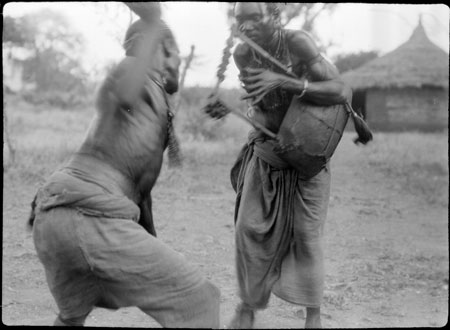Ingessana ritual dance

103 x 76 mm | Negative film nitrate
Date of Print:
Unknown
Previous PRM Number:
EP.D.233
Previous Other Number:
BB 9
Accession Number:
1998.344.233
Description:
Two men from a group of calk players enacting a dance for Evans-Pritchard near his hut in Soda district, with one playing a stringed instrument with a resonator below and another dancing in front of him.
This community group led by a hereditary female ritual expert (tau:n) are primarily concerned with the promotion of life forces in the community (hence their ribaldry and disorganisation) and specifically with children and twins.
Photographer:
Edward Evan Evans-Pritchard
Date of Photo:
1926 November - December
Region:
Blue Nile Tabi Hills Soda
Group:
Ingessana (Gaam)
PRM Source:
Edward Evan Evans-Pritchard
Acquired:
Donated 1966
Other Owners:
E. E. Evans-Pritchard Collection
Class:
Religion , Ritual , Dance , Music
Keyword:
Dance Accessory , Musical Instrument String
Activity:
Dancing
Event:
Performance
Documentation:
Original catalogue lists in Manuscript Collections. Additional material in related documents files. [CM 27/9/2005]
Primary Documentation:
PRM Accession Records - Accession Book Entry [p.
98] 1966.27 [1 - 24] G[ift] PROFESSOR E.
E.
EVANS-PRITCHARD; INST.
OF SOCIAL ANTHROPOLOGY, 51 BANBURY RD.
OXFORD - 1966.27.19 - S.
SUDAN, DARFUNG.
VARIOUS TRIBES.
Box of negatives in envelopes, [1 - 242] & 1966.27.20 - Box of prints of these negatives [refers to object 1966.27.19] [1 - 242], in envelopes.
Manual Catalogues [typewritten, entitled "Ingassana"] - 233. Ceremonial dance of Calk . BB-9
Note on negative scratched - "BB-9"
Manual Catalogues [typewritten, entitled "Ingassana"] - 233. Ceremonial dance of Calk . BB-9
Note on negative scratched - "BB-9"
Other Information:
In A Preliminary Account of the Ingassana Tribe in Fung Province, Sudan Notes and Records X, 1927, page 74, E.
E.
Evans-Pritchard notes 'Chalk.
These are players who function at marriage, the birth of twins and the illness of children.
The head of these players possesses a wooden figure of a man or of a woman, or both, and also a wooden phallus with which he plays.
The office is generally hereditary, but anyone who learns the dances may play.' The calk institution is also discussed in detail in chapter 8 (pp.65-77) of M.C.
Jedrej's Ingessana: The Religious Institutions of a People of the Sudan-Ethiopia Borderland (E.J.Brill, The Netherlands 1995)[Chris Morton 4/2/2004]
Recorder:
Christopher Morton 5/2/2004 [Southern Sudan Project]

